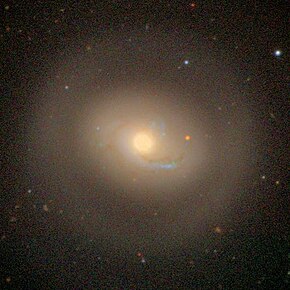NGC 4457
| NGC 4457 | |
|---|---|
 SDSS image of the spiral galaxy NGC 4457. | |
| Observation data (J2000 epoch) | |
| Constellation | Virgo |
| Right ascension | 12h 28m 59.0s[1] |
| Declination | 03° 34′ 14″[1] |
| Redshift | 0.002942[1] |
| Heliocentric radial velocity | 882 km/s[1] |
| Distance | 54,801,600 ly |
| Group or cluster | Virgo II Groups |
| Apparent magnitude (V) | 11.76[1] |
| Characteristics | |
| Type | (R)SAB(s)0/a, LINER[1] |
| Size | ~ 38,687.32 ly |
| Apparent size (V) | 2.7 × 2.3[1] |
| Other designations | |
| CGCG 42-124, IRAS 12264+0350, MCG 1-32-75, PGC 41101, UGC 7609, VCC 1145 [1] | |
NGC 4457 is an intermediate spiral galaxy located about 55 million light-years away[2] in the constellation of Virgo.[3] It is also classified as a LINER galaxy, a class of active galaxy defined by their spectral line emissions.[4][2] NGC 4457 Is inclined by about 33°.[5] It was discovered by astronomer William Herschel on February 23, 1784.[6] Despite being listed in the Virgo Cluster Catalog as VCC 1145,[7] NGC 4457 is a member of the Virgo II Groups[8][9][10] which form an extension of the Virgo cluster.[8][11]
NGC 4457 may have had a recent minor merger with another galaxy.[12]
On July 1 2020 an astronomical transient was discovered in NGC 4457 by astronomer Kiochi Itagaki and confirmed by ASAS-SN. Spectroscopic classification determined the object to be a Type Ia Supernova, SN 2020nvb.[13]
Physical characteristics
NGC 4457 has a broad oval zone containing an inner spiral which is defined mainly by two fairly open arms. There is a well-defined outer ring that is completely detached from the inner regions of the galaxy.[14]
Truncated disk
NGC 4457 has a severely reduced amount of star-formation in its disk while its inner regions have a normalized rate of massive star formation.[14] This may have been caused by a recent interaction of the gas in the galaxy with the gas in the surrounding Virgo Cluster,[15] causing the gas to be stripped away in an effect known as ram-pressure stripping.[16]
See also
- List of NGC objects (4001–5000)
- Messier 90
- Comet Galaxy - a distant galaxy in the cluster Abell 2667 which is experiencing ram-pressure stripping as well
Gallery
-
Hubble Space Telescope image of NGC 4457
-
NGC 4457 (SDSS DR14)
References
- ^ a b c d e f g h "NASA/IPAC Extragalactic Database". Results for NGC 4457. Retrieved 2017-08-18.
- ^ a b "Your NED Search Results". ned.ipac.caltech.edu. Retrieved 2017-08-19.
- ^ Rojas, Sebastián García. "Galaxy NGC 4457 - Galaxy in Virgo Constellation · Deep Sky Objects Browser". DSO Browser. Retrieved 2017-08-19.
- ^ TERASHIMA, YUICHI; HO, LUIS C.; PTAK, ANDREW F.; MUSHOTZKY, RICHARD F.; SERLEMITSOS, PETER J.; YAQOOB, TAHIR; KUNIEDA, HIDEYO (20 April 2000). "ASCA Observations of "Type 2" LINERs: Evidence for a Stellar Source of Ionization". The Astrophysical Journal. 533 (2): 729–743. arXiv:astro-ph/9911340. Bibcode:2000ApJ...533..729T. doi:10.1086/308690. S2CID 14130773.
- ^ Vollmer, B.; Soida, M.; Beck, R.; Chung, A.; Urbanik, M.; Chyzy, K.T.; Otmianowska-Mazur, K.; Kenney, J.D.P. (4 April 2013). "Large-scale radio continuum properties of 19 Virgo cluster galaxies⋆ The influence of tidal interactions, ram pressure stripping, and accreting gas envelopes". Astronomy & Astrophysics. 553: 38. arXiv:1304.1279. Bibcode:2013A&A...553A.116V. doi:10.1051/0004-6361/201321163. S2CID 119190841.
- ^ "New General Catalog Objects: NGC 4450 - 4499". cseligman.com. Retrieved 2017-08-18.
- ^ Binggeli, B.; Sandage, A.; Tammann, G. A. (September 1985). "Studies of the Virgo Cluster. II - A catalog of 2096 galaxies in the Virgo Cluster area. V - Luminosity functions of Virgo Cluster galaxies". The Astronomical Journal. 90: 1681. Bibcode:1985AJ.....90.1681B. doi:10.1086/113874. ISSN 0004-6256.
- ^ a b Tully, R. B. (June 1982). "The Local Supercluster". The Astrophysical Journal. 257: 389–422. Bibcode:1982ApJ...257..389T. doi:10.1086/159999. ISSN 0004-637X.
- ^ Koopmann, Rebecca A.; Kenney, Jeffrey D. P.; Young, Judith (2001). "An Atlas of Hα and R Images and Radial Profiles of 63 Bright Virgo Cluster Spiral Galaxies". The Astrophysical Journal Supplement Series. 135 (2): 125–154. arXiv:astro-ph/0106335. Bibcode:2001ApJS..135..125K. doi:10.1086/323532. ISSN 0067-0049. S2CID 14603109.
- ^ Binggeli, B.; Popescu, C. C; Tammann, G. A. (April 11, 1993). "The kinematics of the Virgo cluster revisited" (PDF). Astronomy and Astrophysics Supplement Series. 98: 275–296. Bibcode:1993A&AS...98..275B.
- ^ "The Virgo II Groups". www.atlasoftheuniverse.com. Retrieved 2018-04-25.
- ^ Vollmer, B.; Soida, M.; Beck, R.; Chung, A.; Urbanik, M.; Chyży, K. T.; Otmianowska-Mazur, K.; Kenney, J. D. P. (May 2013). "Large-scale radio continuum properties of 19 Virgo cluster galaxies". Astronomy & Astrophysics. 553: A116. arXiv:1304.1279. Bibcode:2013A&A...553A.116V. doi:10.1051/0004-6361/201321163. ISSN 0004-6361. S2CID 119190841.
- ^ SN 2020nvb TNS
- ^ a b "NGC 4457 - (R)SAB(s)a". The de Vaucouleurs Atlas of Galaxies. Retrieved 2017-08-19.
- ^ Cortes, Juan R.; Kenney, Jeffrey D. P.; Hardy, Eduardo (24 December 2014). "Integral-Field Stellar and Ionized Gas Kinematics of Peculiar Virgo Cluster Spiral Galaxies". The Astrophysical Journal Supplement Series. 216 (1): 9. arXiv:1411.3387. Bibcode:2015ApJS..216....9C. doi:10.1088/0067-0049/216/1/9. S2CID 53658261.
- ^ "Robert A. Piontek -- Ram Pressure Stripping". www.aip.de. Archived from the original on 2016-10-16. Retrieved 2017-08-19.
External links
- NGC 4457 on WikiSky: DSS2, SDSS, GALEX, IRAS, Hydrogen α, X-Ray, Astrophoto, Sky Map, Articles and images
- Sasmirala page on NGC 4457


